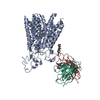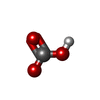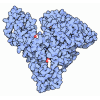+ Open data
Open data
- Basic information
Basic information
| Entry |  | |||||||||
|---|---|---|---|---|---|---|---|---|---|---|
| Title | Human OATP1B3 | |||||||||
 Map data Map data | bicarbonate-bound OATP1B3 with Fab19 | |||||||||
 Sample Sample |
| |||||||||
 Keywords Keywords | organic anion / bicarbonate / SLCO1B3 / uptake / drug / transporter / polypeptide / liver / TRANSPORT PROTEIN | |||||||||
| Function / homology |  Function and homology information Function and homology informationDefective SLCO1B3 causes hyperbilirubinemia, Rotor type (HBLRR) / Organic anion transport by SLCO transporters / sodium-independent organic anion transport / : / heme catabolic process / Atorvastatin ADME / organic anion transport / : / bile acid transmembrane transporter activity / Heme degradation ...Defective SLCO1B3 causes hyperbilirubinemia, Rotor type (HBLRR) / Organic anion transport by SLCO transporters / sodium-independent organic anion transport / : / heme catabolic process / Atorvastatin ADME / organic anion transport / : / bile acid transmembrane transporter activity / Heme degradation / bile acid and bile salt transport / Recycling of bile acids and salts / monoatomic ion transport / xenobiotic metabolic process / basal plasma membrane / serine-type endopeptidase inhibitor activity / basolateral plasma membrane / plasma membrane Similarity search - Function | |||||||||
| Biological species |  Homo sapiens (human) Homo sapiens (human) | |||||||||
| Method | single particle reconstruction / cryo EM / Resolution: 2.97 Å | |||||||||
 Authors Authors | Ciuta A-D / Nosol K / Kowal J / Mukherjee S / Ramirez AS / Stieger B / Kossiakoff AA / Locher KP | |||||||||
| Funding support |  Switzerland, Switzerland,  United States, 2 items United States, 2 items
| |||||||||
 Citation Citation |  Journal: Nat Commun / Year: 2023 Journal: Nat Commun / Year: 2023Title: Structure of human drug transporters OATP1B1 and OATP1B3. Authors: Anca-Denise Ciută / Kamil Nosol / Julia Kowal / Somnath Mukherjee / Ana S Ramírez / Bruno Stieger / Anthony A Kossiakoff / Kaspar P Locher /   Abstract: The organic anion transporting polypeptides OATP1B1 and OATP1B3 are membrane proteins that mediate uptake of drugs into the liver for subsequent conjugation and biliary excretion, a key step in drug ...The organic anion transporting polypeptides OATP1B1 and OATP1B3 are membrane proteins that mediate uptake of drugs into the liver for subsequent conjugation and biliary excretion, a key step in drug elimination from the human body. Polymorphic variants of these transporters can cause reduced drug clearance and adverse drug effects such as statin-induced rhabdomyolysis, and co-administration of OATP substrates can lead to damaging drug-drug interaction. Despite their clinical relevance in drug disposition and pharmacokinetics, the structure and mechanism of OATPs are unknown. Here we present cryo-EM structures of human OATP1B1 and OATP1B3 bound to synthetic Fab fragments and in functionally distinct states. A single estrone-3-sulfate molecule is bound in a pocket located in the C-terminal half of OATP1B1. The shape and chemical nature of the pocket rationalize the preference for diverse organic anions and allow in silico docking of statins. The structure of OATP1B3 is determined in a drug-free state but reveals a bicarbonate molecule bound to the conserved signature motif and a histidine residue that is prevalent in OATPs exhibiting pH-dependent activity. | |||||||||
| History |
|
- Structure visualization
Structure visualization
| Supplemental images |
|---|
- Downloads & links
Downloads & links
-EMDB archive
| Map data |  emd_17655.map.gz emd_17655.map.gz | 316.6 MB |  EMDB map data format EMDB map data format | |
|---|---|---|---|---|
| Header (meta data) |  emd-17655-v30.xml emd-17655-v30.xml emd-17655.xml emd-17655.xml | 20.8 KB 20.8 KB | Display Display |  EMDB header EMDB header |
| FSC (resolution estimation) |  emd_17655_fsc.xml emd_17655_fsc.xml | 18.2 KB | Display |  FSC data file FSC data file |
| Images |  emd_17655.png emd_17655.png | 96.4 KB | ||
| Filedesc metadata |  emd-17655.cif.gz emd-17655.cif.gz | 7.1 KB | ||
| Others |  emd_17655_half_map_1.map.gz emd_17655_half_map_1.map.gz emd_17655_half_map_2.map.gz emd_17655_half_map_2.map.gz | 314.6 MB 315.2 MB | ||
| Archive directory |  http://ftp.pdbj.org/pub/emdb/structures/EMD-17655 http://ftp.pdbj.org/pub/emdb/structures/EMD-17655 ftp://ftp.pdbj.org/pub/emdb/structures/EMD-17655 ftp://ftp.pdbj.org/pub/emdb/structures/EMD-17655 | HTTPS FTP |
-Validation report
| Summary document |  emd_17655_validation.pdf.gz emd_17655_validation.pdf.gz | 1 MB | Display |  EMDB validaton report EMDB validaton report |
|---|---|---|---|---|
| Full document |  emd_17655_full_validation.pdf.gz emd_17655_full_validation.pdf.gz | 1 MB | Display | |
| Data in XML |  emd_17655_validation.xml.gz emd_17655_validation.xml.gz | 25.6 KB | Display | |
| Data in CIF |  emd_17655_validation.cif.gz emd_17655_validation.cif.gz | 33.8 KB | Display | |
| Arichive directory |  https://ftp.pdbj.org/pub/emdb/validation_reports/EMD-17655 https://ftp.pdbj.org/pub/emdb/validation_reports/EMD-17655 ftp://ftp.pdbj.org/pub/emdb/validation_reports/EMD-17655 ftp://ftp.pdbj.org/pub/emdb/validation_reports/EMD-17655 | HTTPS FTP |
-Related structure data
| Related structure data |  8pg0MC  8phwC M: atomic model generated by this map C: citing same article ( |
|---|---|
| Similar structure data | Similarity search - Function & homology  F&H Search F&H Search |
- Links
Links
| EMDB pages |  EMDB (EBI/PDBe) / EMDB (EBI/PDBe) /  EMDataResource EMDataResource |
|---|---|
| Related items in Molecule of the Month |
- Map
Map
| File |  Download / File: emd_17655.map.gz / Format: CCP4 / Size: 421.9 MB / Type: IMAGE STORED AS FLOATING POINT NUMBER (4 BYTES) Download / File: emd_17655.map.gz / Format: CCP4 / Size: 421.9 MB / Type: IMAGE STORED AS FLOATING POINT NUMBER (4 BYTES) | ||||||||||||||||||||||||||||||||||||
|---|---|---|---|---|---|---|---|---|---|---|---|---|---|---|---|---|---|---|---|---|---|---|---|---|---|---|---|---|---|---|---|---|---|---|---|---|---|
| Annotation | bicarbonate-bound OATP1B3 with Fab19 | ||||||||||||||||||||||||||||||||||||
| Projections & slices | Image control
Images are generated by Spider. | ||||||||||||||||||||||||||||||||||||
| Voxel size | X=Y=Z: 0.51 Å | ||||||||||||||||||||||||||||||||||||
| Density |
| ||||||||||||||||||||||||||||||||||||
| Symmetry | Space group: 1 | ||||||||||||||||||||||||||||||||||||
| Details | EMDB XML:
|
-Supplemental data
-Half map: bicarbonate-bound OATP1B3 with Fab19 (half-map 1)
| File | emd_17655_half_map_1.map | ||||||||||||
|---|---|---|---|---|---|---|---|---|---|---|---|---|---|
| Annotation | bicarbonate-bound OATP1B3 with Fab19 (half-map 1) | ||||||||||||
| Projections & Slices |
| ||||||||||||
| Density Histograms |
-Half map: bicarbonate-bound OATP1B3 with Fab19 (half-map 2)
| File | emd_17655_half_map_2.map | ||||||||||||
|---|---|---|---|---|---|---|---|---|---|---|---|---|---|
| Annotation | bicarbonate-bound OATP1B3 with Fab19 (half-map 2) | ||||||||||||
| Projections & Slices |
| ||||||||||||
| Density Histograms |
- Sample components
Sample components
-Entire : Human OATP1B3
| Entire | Name: Human OATP1B3 |
|---|---|
| Components |
|
-Supramolecule #1: Human OATP1B3
| Supramolecule | Name: Human OATP1B3 / type: complex / ID: 1 / Parent: 0 / Macromolecule list: #1-#3 |
|---|---|
| Source (natural) | Organism:  Homo sapiens (human) Homo sapiens (human) |
| Molecular weight | Theoretical: 180 KDa |
-Macromolecule #1: Solute carrier organic anion transporter family member 1B3
| Macromolecule | Name: Solute carrier organic anion transporter family member 1B3 type: protein_or_peptide / ID: 1 / Number of copies: 1 / Enantiomer: LEVO |
|---|---|
| Source (natural) | Organism:  Homo sapiens (human) Homo sapiens (human) |
| Molecular weight | Theoretical: 77.478586 KDa |
| Recombinant expression | Organism:  Homo sapiens (human) Homo sapiens (human) |
| Sequence | String: MDQHQHLNKT AESASSEKKK TRRCNGFKMF LAALSFSYIA KALGGIIMKI SITQIERRFD ISSSLAGLID GSFEIGNLLV IVFVSYFGS KLHRPKLIGI GCLLMGTGSI LTSLPHFFMG YYRYSKETHI NPSENSTSSL STCLINQTLS FNGTSPEIVE K DCVKESGS ...String: MDQHQHLNKT AESASSEKKK TRRCNGFKMF LAALSFSYIA KALGGIIMKI SITQIERRFD ISSSLAGLID GSFEIGNLLV IVFVSYFGS KLHRPKLIGI GCLLMGTGSI LTSLPHFFMG YYRYSKETHI NPSENSTSSL STCLINQTLS FNGTSPEIVE K DCVKESGS HMWIYVFMGN MLRGIGETPI VPLGISYIDD FAKEGHSSLY LGSLNAIGMI GPVIGFALGS LFAKMYVDIG YV DLSTIRI TPKDSRWVGA WWLGFLVSGL FSIISSIPFF FLPKNPNKPQ KERKISLSLH VLKTNDDRNQ TANLTNQGKN VTK NVTGFF QSLKSILTNP LYVIFLLLTL LQVSSFIGSF TYVFKYMEQQ YGQSASHANF LLGIITIPTV ATGMFLGGFI IKKF KLSLV GIAKFSFLTS MISFLFQLLY FPLICESKSV AGLTLTYDGN NSVASHVDVP LSYCNSECNC DESQWEPVCG NNGIT YLSP CLAGCKSSSG IKKHTVFYNC SCVEVTGLQN RNYSAHLGEC PRDNTCTRKF FIYVAIQVIN SLFSATGGTT FILLTV KIV QPELKALAMG FQSMVIRTLG GILAPIYFGA LIDKTCMKWS TNSCGAQGAC RIYNSVFFGR VYLGLSIALR FPALVLY IV FIFAMKKKFQ GKDTKASDNE RKVMDEANLE FLNNGEHFVP SAGTDSKTCN LDMQDNAAAN UniProtKB: Solute carrier organic anion transporter family member 1B3 |
-Macromolecule #2: Fab19 (heavy chain, variable region)
| Macromolecule | Name: Fab19 (heavy chain, variable region) / type: protein_or_peptide / ID: 2 / Number of copies: 1 / Enantiomer: LEVO |
|---|---|
| Source (natural) | Organism:  Homo sapiens (human) Homo sapiens (human) |
| Molecular weight | Theoretical: 25.599549 KDa |
| Recombinant expression | Organism:  |
| Sequence | String: EISEVQLVES GGGLVQPGGS LRLSCAASGF NFSSSSIHWV RQAPGKGLEW VASISSSSGS TSYADSVKGR FTISADTSKN TAYLQMNSL RAEDTAVYYC ARYYIKRWWL MSWEDYSMGL DYWGQGTLVT VSSASTKGPS VFPLAPSSKS TSGGTAALGC L VKDYFPEP ...String: EISEVQLVES GGGLVQPGGS LRLSCAASGF NFSSSSIHWV RQAPGKGLEW VASISSSSGS TSYADSVKGR FTISADTSKN TAYLQMNSL RAEDTAVYYC ARYYIKRWWL MSWEDYSMGL DYWGQGTLVT VSSASTKGPS VFPLAPSSKS TSGGTAALGC L VKDYFPEP VTVSWNSGAL TSGVHTFPAV LQSSGLYSLS SVVTVPSSSL GTQTYICNVN HKPSNTKVDK KVEPKSCDKT HT |
-Macromolecule #3: Fab19 (light chain, variable region)
| Macromolecule | Name: Fab19 (light chain, variable region) / type: protein_or_peptide / ID: 3 / Number of copies: 1 / Enantiomer: LEVO |
|---|---|
| Source (natural) | Organism:  Homo sapiens (human) Homo sapiens (human) |
| Molecular weight | Theoretical: 23.258783 KDa |
| Recombinant expression | Organism:  |
| Sequence | String: SDIQMTQSPS SLSASVGDRV TITCRASQSV SSAVAWYQQK PGKAPKLLIY SASSLYSGVP SRFSGSRSGT DFTLTISSLQ PEDFATYYC QQSSSSLITF GQGTKVEIKR TVAAPSVFIF PPSDSQLKSG TASVVCLLNN FYPREAKVQW KVDNALQSGN S QESVTEQD ...String: SDIQMTQSPS SLSASVGDRV TITCRASQSV SSAVAWYQQK PGKAPKLLIY SASSLYSGVP SRFSGSRSGT DFTLTISSLQ PEDFATYYC QQSSSSLITF GQGTKVEIKR TVAAPSVFIF PPSDSQLKSG TASVVCLLNN FYPREAKVQW KVDNALQSGN S QESVTEQD SKDSTYSLSS TLTLSKADYE KHKVYACEVT HQGLSSPVTK SFNRGEC |
-Macromolecule #4: 2-acetamido-2-deoxy-beta-D-glucopyranose
| Macromolecule | Name: 2-acetamido-2-deoxy-beta-D-glucopyranose / type: ligand / ID: 4 / Number of copies: 1 / Formula: NAG |
|---|---|
| Molecular weight | Theoretical: 221.208 Da |
| Chemical component information |  ChemComp-NAG: |
-Macromolecule #5: BICARBONATE ION
| Macromolecule | Name: BICARBONATE ION / type: ligand / ID: 5 / Number of copies: 1 / Formula: BCT |
|---|---|
| Molecular weight | Theoretical: 61.017 Da |
| Chemical component information |  ChemComp-BCT: |
-Macromolecule #6: CHOLESTEROL
| Macromolecule | Name: CHOLESTEROL / type: ligand / ID: 6 / Number of copies: 3 / Formula: CLR |
|---|---|
| Molecular weight | Theoretical: 386.654 Da |
| Chemical component information |  ChemComp-CLR: |
-Experimental details
-Structure determination
| Method | cryo EM |
|---|---|
 Processing Processing | single particle reconstruction |
| Aggregation state | particle |
- Sample preparation
Sample preparation
| Concentration | 0.59 mg/mL |
|---|---|
| Buffer | pH: 7.4 |
| Vitrification | Cryogen name: ETHANE-PROPANE |
- Electron microscopy
Electron microscopy
| Microscope | FEI TITAN KRIOS |
|---|---|
| Image recording | Film or detector model: GATAN K3 BIOQUANTUM (6k x 4k) / Average electron dose: 60.5 e/Å2 |
| Electron beam | Acceleration voltage: 300 kV / Electron source:  FIELD EMISSION GUN FIELD EMISSION GUN |
| Electron optics | C2 aperture diameter: 100.0 µm / Illumination mode: FLOOD BEAM / Imaging mode: BRIGHT FIELD / Cs: 2.7 mm / Nominal defocus max: 2.2 µm / Nominal defocus min: 0.6 µm |
| Sample stage | Specimen holder model: FEI TITAN KRIOS AUTOGRID HOLDER / Cooling holder cryogen: NITROGEN |
| Experimental equipment |  Model: Titan Krios / Image courtesy: FEI Company |
 Movie
Movie Controller
Controller












 Z (Sec.)
Z (Sec.) Y (Row.)
Y (Row.) X (Col.)
X (Col.)





































